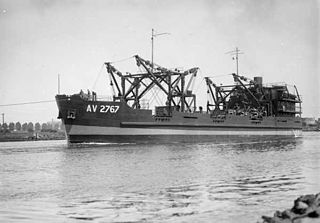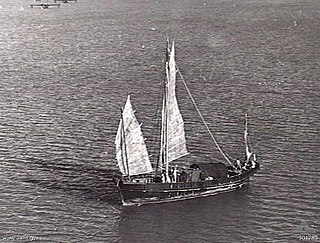
HMAS Queenborough (G70/D270/F02/57) was a Q-class destroyer that served in the Royal Navy (RN) and Royal Australian Navy (RAN).

HMAS Benalla (J323/M323), named for the city of Benalla, Victoria, was one of 60 Bathurst-class corvettes constructed during World War II, and one of 36 initially manned and commissioned solely by the Royal Australian Navy (RAN). Built by HMA Naval Dockyard in Victoria, Benalla was fitted out as armed survey ship instead of a minesweeper like the rest of the class, and was commissioned into the RAN in 1943.

HMAS Horsham (J235/M235), named for the city of Horsham, Victoria, was one of 60 Bathurst-class corvettes constructed during World War II, and one of 36 initially manned and commissioned solely by the Royal Australian Navy (RAN).

HMAS Ipswich (J186/B244/A118), named for the city of Ipswich, Queensland, was one of 60 Bathurst-class corvettes built during World War II and one of 20 built on Admiralty order but manned by personnel of and later commissioned into the Royal Australian Navy (RAN).

The Bathurst-class corvettes were a class of general purpose vessels designed and built in Australia during World War II. Originally classified as minesweepers, but widely referred to as corvettes, the Bathurst-class vessels fulfilled a broad anti-submarine, anti-mine, and convoy escort role.

HMAS Kanimbla was a passenger ship converted for use as an armed merchant cruiser and landing ship infantry during World War II. Built during the mid-1930s as the passenger liner MV Kanimbla for McIlwraith, McEacharn & Co, the ship operated in Australian waters until 1939, when she was requisitioned for military service, converted into an armed merchant cruiser, and commissioned in the Royal Navy as HMS Kanimbla.

USS Wallace L. Lind (DD-703), was an Allen M. Sumner-class destroyer of the United States Navy.

HMAS Manoora was an ocean liner that served in the Royal Australian Navy (RAN) during World War II. She was built in Scotland in 1935 for the Cairns to Fremantle coastal passenger run for the Adelaide Steamship Company. She was requisitioned by the RAN for naval service in 1939. Manoora was initially converted into an armed merchant cruiser (AMC), operating primarily in Australian, New Guinea, and Pacific waters, with deployments to Singapore and the Bay of Bengal.

HMAS Bathurst (J158), named for the city of Bathurst, New South Wales, was the lead ship of 60 Bathurst-class corvettes constructed during World War II and one of 20 built for the Admiralty but manned by personnel of and commissioned into the Royal Australian Navy (RAN). Constructed during 1940, the ship spent most of her early career operating with the British Eastern Fleet in the Indian Ocean. She returned to Australian waters in late 1944, then was deployed to New Guinea in 1945, but saw little action. Bathurst was paid off in 1946, and sold to a Sydney scrap merchant in 1948.

HMS Gnat was a Royal Navy Insect-class gunboat. She was built by Lobnitz and launched in 1915. Gnat saw service during the First World War as part of a flotilla operating on the Tigris and Euphrates rivers. After the war, the vessel was transferred to China, where in 1927, Gnat took part in the Nanking Incident. Gnat began the Second World War still in China, but was towed to the Mediterranean Sea in 1940. There, the gunboat took part in an assault on Tobruk before being torpedoed by a German submarine. Though Gnat did not sink, and was beached at Alexandria, Egypt where the vessel was used as an anti-aircraft platform. The vessel was declared a constructive total loss and scrapped in 1945.

HMS Neasham (M2712/IMS49) was a Ham-class minesweeper for the Royal Navy. The names of the Ham-class vessels were all chosen from villages ending in -ham. HMS Neasham was named after Neasham in County Durham.

HMAS Dubbo (J251/M251), named for the city of Dubbo, was one of 60 Bathurst-class corvettes constructed during World War II, and one of 36 initially manned and commissioned solely by the Royal Australian Navy (RAN).

HMAS Whyalla (J153/B252), named for the city of Whyalla was one of 60 Bathurst-class corvettes constructed during World War II and one of 20 built on Admiralty order but manned by personnel of and later commissioned into the Royal Australian Navy (RAN). The ship was sold to the Victorian Public Works Department at the end of the war, who renamed her Rip and used her as a maintenance ship. In 1984, she was purchased by Whyalla City Council, who put her on display as a landlocked museum ship in 1987.

HMAS Fremantle (J246/M246), named for the port city of Fremantle, Western Australia, was one of 60 Bathurst-class corvettes constructed during World War II, and one of 36 initially manned and commissioned solely by the Royal Australian Navy (RAN).

HMAS Gladstone (J324/M324), named for the city of Gladstone, Queensland, was one of 60 Bathurst class corvettes constructed during World War II, and one of 36 that were initially manned and commissioned solely by the Royal Australian Navy (RAN). Built by Walkers Limited, the ship was commissioned in 1943.

Crusader (AV2767) was an Australian Army amphibious operations support ship of World War II. She was launched shortly before the war ended and entered service in late 1945. From 1945 to 1947 she was mainly used to return Australian Army equipment from the islands off New Guinea. She was also loaned to the Australian Shipping Board in early 1947 and transported earth moving equipment and timber between Melbourne and Tasmania. However, the Army did not need a ship with Crusader's capabilities after the war, and she was sold in 1947 to the Queensland Cement and Lime Company which operated her as a coral barge on the Brisbane River until the mid-1980s. The ship was scuttled in 1986 and became a popular dive wreck.

The Snake-class junks were a class of six small vessels operated by the Royal Australian Navy (RAN) to support special forces operations in 1944 and 1945. The ships were lightly armed and were used to infiltrate special forces parties and their supplies into Japanese-held territory.

HMAS Doomba was a Royal Australian Navy (RAN) warship of World War II. Built for the Royal Navy around the end of World War I as the Hunt-class minesweeper HMS Wexford, the ship only saw two years of service before she was decommissioned in 1921 and sold to the Doomba Shipping Company. The vessel was renamed SS Doomba, converted into a passenger ship, and operated in the waters around Brisbane until 1939, when she was requisitioned by the RAN for wartime service. Serving first as an auxiliary minehunter, then an auxiliary anti-submarine vessel, HMAS Doomba was purchased outright by the RAN in 1940, and served until early 1946, when she was sold and converted into a linseed oil lighter. Doomba was scuttled off Dee Why, New South Wales in 1976.
HMAS Eduardo was an auxiliary vessel operated by the Royal Australian Navy (RAN) during the Second World War. She was the Royal Navy's MFV 2045, which was loaned to the RAN and commissioned on 8 March 1945. She was used by the Services Reconnaissance Department and was paid off in October 1945 and handed back to the Royal Navy.
HMAS Nyanie was an auxiliary vessel operated by the Royal Australian Navy (RAN) during the Second World War. She was commissioned on 6 July 1945. She was used by the Services Reconnaissance Department and was paid off in 1945, before being transferred to the Australian Army.

















